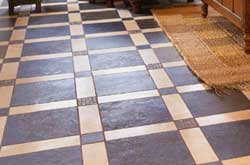Hardwood Flooring Installation Options
See if We Have Top-Rated
Flooring Contractors in Your Area

When it comes to renovating a house, hardwood flooring installation is one of the most common projects around. When it comes time to get rid of the carpet and put in something new, many homeowners choose hardwood for both its natural beauty and for the value it can add to the property, as well.
Traditional Hardwood Flooring Installation
True hardwood flooring installation is a pretty big job if it is to be done properly. Since solid wood tends to bow and bend when exposed to excessive moisture or heat, the first step in hardwood flooring installation is to prepare the sub-floor (whatever it may be) and make it perfectly clean, level, and moisture tight.
In traditional installation, after the sub-floor is properly prepared, the boards are nailed down end-to-end from a specified starting point (often the room's focal point). As each subsequent row is laid down, the joints where the edges meet are staggered so that they are at least 12 inches away from the joints in the previous row. After everything is in place, the boards are sealed and finished.
Contemporary Hardwood Flooring Installation
Traditional hardwood flooring installation is a laborious process. There are many new techniques (and a few new materials that mimic hardwood) that make the job faster and less strenuous.
The method you use to install your flooring will often depend on the boards you purchase. Some hardwood can be purchased with an interlocking tongue-and-groove system that allows the boards to be snapped together. Some hardwood is actually meant to be glued down instead of being nailed. Some hardwood comes pre-finished, so that after you lay it down, the work is essentially over. Furthermore, new products have been produced that do the basic job of hardwood, but have some other good qualities that the real thing doesn't possess.
Tired of that same old floor? Use this link to
Install New Flooring Laminate Flooring
Laminate flooring, though not actually made of hardwood, looks very much like real wood when installed. Laminate consists of a high density core with a photographic layer on the top that looks like wood. This photographic layer is then sealed with polyurethane, making it very scratch and stain resistant. It can be installed in places that true hardwood probably shouldn't go and is much less expensive. Installation of laminate flooring uses a "floating" tongue-and-groove method, making it easier to install: Laminate can also be easily pulled up and reinstalled elsewhere.
Engineered Hardwood Flooring Installation
Engineered hardwood is a relatively new building material. It consists of multiple layers of wood (these can be made of plywood, high density fiberboard, or, in some cases, true hardwood). The surface is a hardwood veneer or thin layer of sawn hardwood that varies in thickness.
Many homeowners are opting for engineered hardwood because it combines the look and feel of actual wood with the versatility and moisture resistance of a laminate. It is an excellent choice for placement above radiant heat or in climates that are very humid. Engineered hardwood is usually installed in much the same way as traditional hardwood, but can handle situations that could warp and bow true hardwood.

